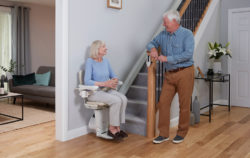Approximately one out of every four persons age 65 and older fall each year. There is an inescapable correlation between falling and aging. Once a person has fallen once, the chance of them falling again doubles. A slip or fall for a senior can be extremely serious. Therefore, it is extremely important to be aware of risk factors that increase the likelihood of a slip or fall, as well as to put prevention measures in place. These conditions make a slip or fall accident at home much more likely.
Hearing Loss
Researchers at Johns Hopkins School of Medicine report hearing loss can exponentially increase your chances of falling. The research unveiled a startling conclusion. The odds of falling increase by 140% for every 10 dB of hearing loss.
Many individuals who experience hearing loss attempt to hide the problem by withdrawing from social situations or taking steps to compensate for the inability to hear. Openly discussing the first signs of hearing loss may help prevent or slow further damage and reduce risks of complications due to the loss.
Fear of Falling
If you’ve suffered a fall in the past or you just don’t feel that steady on your feet, you may be unknowingly contributing to your risk of falling. Fear of falling can cause you to become isolated and withdrawn. These circumstances can bring about a decrease in mobility and physical fitness. As your physical abilities decline, your chances of falling increase.
It’s important to keep moving. After a fall, talk to your health care provider about physical therapy, assistive devices, or whatever is necessary to remain active and reduce the risk of falling again.
Difficulty with Balance
It seems obvious that balance problems increase the risk of falling. But, oftentimes, balance problems creep up slowly, and people don’t realize there’s a problem until it’s too late. Conditions that cause muscle weakness and gait problems are clear contributors, but be aware of less obvious conditions such as blood pressure or blood sugar fluctuations, both of which can affect balance.
Again, open communication with your doctor is essential to pinpoint reasons for balance difficulties and perhaps remedy the issue. Physical therapy can also improve balance, and when necessary, a cane, walker, railing or other assistive devices should be used.
Vision Impairment
Eyesight tends to worsen with age. Declining eyesight can take a toll on depth perception and the ability to adjust to poor lighting. These visual challenges increase the risk of falling.
Regular vision checks are even more important as we age, as well as keeping eyeglasses in good condition. At home, ensure that lighting is adequate and that spaces are free from obstacles.
Medication Side Effects
Drowsiness, blurred vision and lightheadedness are frequently listed side effects for a number of medications. Each of these side effects increase the likelihood of falling. Common medications that increase fall risk include sedatives, tranquilizers and some antidepressants, including any medication taken to aid sleep. Even some over the counter medications can contribute to a slip or fall. The more medication an individual takes, the greater the likelihood that a combination of medication will contribute to a fall.

Discuss the risk of each medication with your prescribing physician or pharmacist. Be certain that any over the counter are safe to take with your medication regimen. Medications for sedation or sleep should only be taken when you can rest and will not be moving around.
If you or an aging loved one have begun to experience the symptoms described above, it is wise to talk to your healthcare provider about your risk for falling. Also, assess your home for improvements that can be made to allow aging in place. A stairlift or other assistive device for the home can greatly reduce the chance of a life-altering accident.
